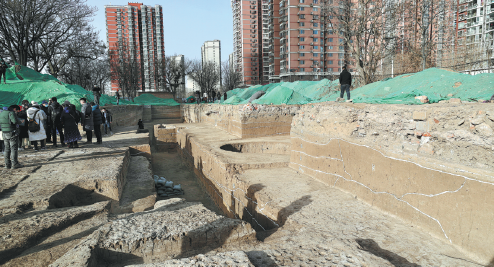New findings unearth Beijing's early days

New key archaeological findings in the southwest of downtown Beijing unveil the city's early years as the "national capital", dating back about 900 years.
The first discovery of outer city wall ruins of Zhongdu, or central capital, of Jin Dynasty (1115-1234) were unearthed in a two-yearlong archaeological research, said the Beijing Municipal Administration of Cultural Heritage on Wednesday.
Ding Lina, the lead archaeologist of the project, said five sections of earthen wall ruins totaling 60 meters were discovered in Fengtai district. They were originally on the western and southern sides of the capital city during the Jin Dynasty.
"The findings help us figure out the basic layout structure of Zhongdu's city walls," said Ding, who is also from the Beijing Archaeological Research Institute.
Jin Dynasty was founded by the Jurchen people who once ruled a vast territory in today's North China. In 1127, its powerful army seized the capital of Song Dynasty (960-1279), which is now known as Kaifeng in Henan province, and took two Song emperors as prisoners, marking the end of Northern Song period (960-1127).
Song royalists moved to Lin'an-known as Hangzhou today-and a lasting military standoff between Jin and Southern Song (1127-1279) started. In 1153, the Jin rulers set its capital in Zhongdu, and the city grew to be a prosperous metropolis.
Beijing then became the capital of a national dynasty for the first time.
Compared with household history of major events that the public knows of, Ding said that remaining historical recordings of Zhongdu city are scarce.
"We don't have much to refer to," she said. "For example, we didn't know how the wall was built, so this archaeological excavation provides crucial evidence."
More than 2,900 square meters of the Zhongdu city wall ruins were unearthed in the last two years. A section of the western wall, which is 24-meter-wide in its thickest part, is the best preserved one among the five. The wall is located near the Lize Financial Business District. As recorded in history, Lize was also the historical name of a Zhongdu city gate.
The city wall was found to be mainly piled up via rammed earth, but some outer protruding parts were also covered by bricks to enhance fortification.
Though the unearthed part only covered a corner of the ancient city, its splendor has come to light through more details.
A 66-meter-wide moat was also excavated, and so were several roads by the wall. Other important relics include broken porcelain pieces, which were burned in Ding Kilns and Jun Kilns, the top-tier ceramic workshops of its time.
Milestone finding
Ding said follow-up architectural studies are needed to speculate how high the walls were and "reconstruct" their appearance.
Some findings may fill the voids in historical recordings, but some have proved written documents.
Historical files showed that Zhongdu was expanded from an existing city of the previous Tang (618-907) and Liao (916-1125) dynasties. Discovery of ancient tombs from these two dynasties, which were buried beneath the Jin Dynasty city wall ruins, matched that recording.
"In ancient China, graveyards were located out of the city," Ding explained. "As Zhongdu expanded, these places were included in the urban area."
In front of the imminent Genghis Khan army to the north, the capital of Jin Dynasty was moved from Zhongdu to Kaifeng in 1214. Zhongdu fell and was destroyed in the war the following year. When Genghis Khan's grandson Kublai Khan founded the Yuan Dynasty (1271-1368), he still chose Beijing as the capital by constructing a new city known as Dadu.
Since the Yuan Dynasty, Beijing has been the national capital of China for most part of the centuries.
"Consequently, the Zhongdu site is a milestone for our studies of Beijing's history as the capital," said Zhang Zhonghua, deputy director of Beijing Archaeological Research Institute.
Zhang added it has a key status for research of Chinese capital cities as a whole through comparative studies.
For instance, Jurchen rulers of the Jin Dynasty tried to learn from the highly developed Song culture, so the design of Zhongdu also mimicked Kaifeng. However, as the Song capital city was buried deep underground due to frequent flooding of the Yellow River and was more difficult to be excavated, Zhang said the Zhongdu ruins in Beijing offered an easier alternative to better research that ancient city in Henan.
According to Fu Ran, an official in charge of cultural heritage protection with the Fengtai district government, a ruins park for the Zhongdu city walls was also planned to better protect the site and display the archaeological discoveries to the public.
wangkaihao@chinadaily.com.cn






















